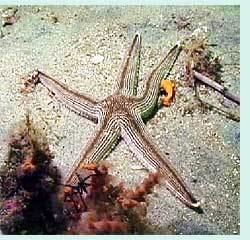Family Luidiidae | Class Asteroidea Rank Species | |
 | ||
Similar Luidia, Luidia senegalensis, Astropecten articulatus, Paxillosida, Astropecten | ||
Luidia clathrata is a tropical species of starfish in the family Luidiidae. It is variously known as the slender armed starfish, the gray sea star or the lined sea star. It is found in the western Atlantic Ocean.
Contents
Description
Luidia clathrata is a large, flattish starfish, sometimes growing to a diameter of 30 centimetres (12 in). It has a relatively small disc and five slender arms, which are two or three times the diameter of the disc. The upper surface of the disc and arms is clad in longitudinal rows of calcified plates called ossicles, and in paxillae, pillar-like spines with flattened summits covered with minute spinules. There are no plates along the margins of the arms, these being replaced by paxillae, but on the underside, the marginal plates are large and themselves covered with paxillae. The tube feet, found in longitudinal rows on the underside, do not have suckers but have two swollen regions. There is a mouth in the centre of the underside, an oesophagus and cardiac stomach which can be everted. The gonads are underneath the sides of each arm. The colour is usually grey or light brown but can be tinged with pink. The central row of plates on the upper side of the arms is usually dark grey or black. The underside of the starfish is a paler colour.
Distribution and habitat
Luidia clathrata is found around the coastlines of the western Atlantic Ocean, from Virginia south to Brazil, the Caribbean Sea and Gulf of Mexico. It is usually on sandy or muddy seabeds down to a depth of about 40 metres (130 ft), although it is occasionally found in deeper waters down to 100 metres (330 ft).
Biology and ecology
When Luidia clathrata loses part or all of an arm through predation, it can regenerate the limb. The damaged area is sealed off, and a new small arm-tip appears within a week. Subsequent development is at the rate of about 3.7 millimetres (0.15 in) a month although this slows down when regeneration is nearly complete. A study on the regenerative capacity of Luidia clathrata found that increased ocean acidification, as is likely to happen under global warming, had no significant effect on the starfish's ability to regenerate its limbs.
Luidia clathrata is both a predator and a forager. It selectively feeds on the "coot clam", Mulinia lateralis, when it is abundant, using chemoreceptors to help it find its prey. The coot clam is the preferred food of L. clathrata in Tampa Bay, Florida. At other times it feeds by ingesting sediment and straining the material through spines round its mouth, extracting food particles in the process. The diet includes both gastropod and bivalve molluscs, foraminiferans, nematodes, ostracods, small crustaceans and detritus. It is photosensitive and mostly spends the daylight hours buried in the sediment. While buried it sometimes everts its stomach to ingest detritus.
Luidia clathrata spawns annually. The larvae pass through a planktonic bipinnaria stage which lasts about a month before settling on the seabed, undergoing metamorphosis and becoming juvenile starfish.
